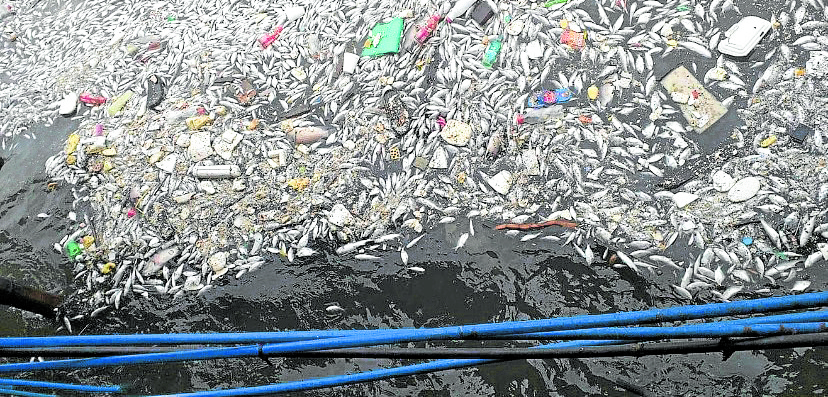‘Impossible’ for Manila Bay ‘white sand’ to cause fish kill — DENR exec

FISHY SITUATION The Bureau of Fisheries and Aquatic Resources said 10 kilos of dead fish were recovered from the waters of Manila Bay earlier this week. It said the fish died due to the very low oxygen level in the polluted waters. The Department of Environment and Natural Resources sees no link between the fish kill and the beach nourishment it is undertaking using crushed dolomite made to look like white sand to beautify a portion of the shore. —PHOTO COURTESY OF URBAN POOR ASSOCIATES
MANILA, Philippines — An official of the Department of Environment and Natural Resources (DENR) on Thursday said it was “impossible” for the artificial white sand or crushed dolomite dumped on the shoreline of Manila Bay to have caused the fishkill in the waters of Manila Bay close to Baseco in Tondo, Manila, earlier this week.
Regine Nequia, president of the Baseco Seaside Neighborhood Association, expressed concern that the DENR’s “beach nourishment” project on the bay might have killed hundreds of fish that were found floating near the Baseco seawall, videos of which circulated on social media on Thursday morning.
The fishkill video taken by Nequia was uploaded by the nonprofit Urban Poor Associates (UPA). The group’s media officer, Princess Esponilla, said UPA wanted the government to look into the problem as about 10 percent of the 22,000 families in Baseco were dependent on fishing.
Sea turned white
“Now you are forced to inquire. The sea turned white and there were lot of dead fish. Where are these from?” Esponilla said, referring also to the change in the water color when the fishkill occurred.
Reacting to statements from the two groups, Environment Undersecretary Benny Antiporda said, “What they’re saying is impossible.”
Article continues after this advertisementHe cited the five-kilometer distance between the beach nourishment site and Baseco. A breakwater structure also separates the two sites, he said.
Article continues after this advertisement“As of now, what I’m saying is that’s unlikely and the allegation that the fishkill came from the nourishment area is erroneous,” he said.
Water quality tests
He said the DENR was investigating the cause of the fishkill and checking the water quality. Water samples were taken from both sites for laboratory tests and the results will be made public on Friday.
“We’re looking at the cyanide level, but hopefully this was not intentional,” Antiporda said.
He said the agency was not discounting the possibility of sabotage like illegal fishing.
Manila Mayor Francisco “Isko Moreno” Domagoso on Thursday said he asked the Bureau of Fisheries and Aquatic Resources (BFAR), an agency under the Department of Agriculture, to also look into the incident and take action.
The BFAR said that around 5 a.m. on Tuesday, Baseco residents reported seeing various varieties of fish, including those locally called “biya,” “kanduli” and “asohos” gasping for air following a heavy rainfall.
BFAR Executive Director Eduardo Gongona told Manila officials that water quality and microbiological analysis of some of the fish were conducted at four sampling sites: Baseco beach area, Pasig River mouth area, barge docking area, and Aplaya area.
The water quality test results showed that the Baseco area had a very low level of dissolved oxygen of 0.11 milligrams per liter. The acceptable level for marine waters is 5 mg/L, Gorgona said.
BFAR said around 10 kilos of dead fish had been recovered in the bay, specifically in the waters in Baseco area.
Gongona found no other “fish mortality incidents” on the bay.
According to Nazario Briguera, spokesperson for the BFAR, fish that die due to lack of oxygen are generally not harmful.
In this case, however, the bureau cautions the public not to eat the dead fish, including those recovered from the shore as they are not sure about the length of exposure and the time the fish were floating.
Fish showing signs of decomposition like bloatedness, disintegration of parts and foul smell, should not be eaten, he said.
This is not the first time that Manila Bay has been hit by fishkill. In October last year, about 30 tubs of dead fish worth over P700,000 were recovered from the Las Piñas-Parañaque Wetland Park.
The DENR then blamed heavy rains for the fishkill, citing tests that showed a low concentration of dissolved oxygen in the water.
According to Antiporda, workers are now putting “finishing touches” to the crushed dolomite overlay on a 500-meter section of the Manila Bay shoreline.
The controversial beach nourishment program is set to be completed on Saturday to mark International Coastal Cleanup day.